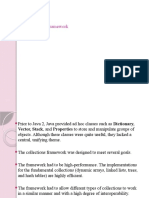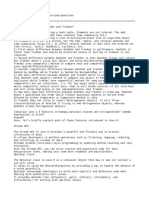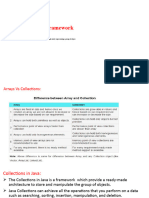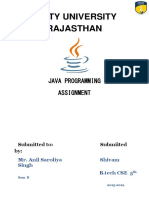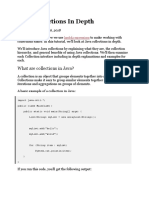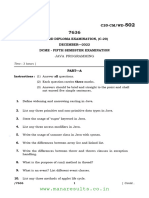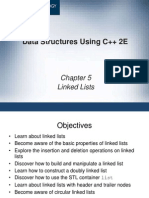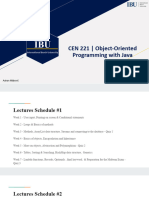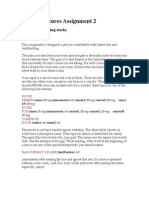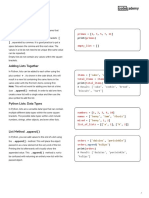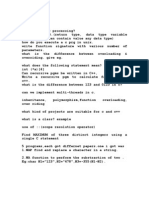Collections
Collections
Uploaded by
Abdul GafurCopyright:
Available Formats
Collections
Collections
Uploaded by
Abdul GafurOriginal Description:
Original Title
Copyright
Available Formats
Share this document
Did you find this document useful?
Is this content inappropriate?
Copyright:
Available Formats
Collections
Collections
Uploaded by
Abdul GafurCopyright:
Available Formats
School of Informatics, University of Edinburgh
Computer Science 1 Ah
CS1Ah Lecture Note 23 The Java Collection Framework
23.1 Introduction
Recent lectures have introduced a number of different kinds of container or collection classes, for example, the Vector, LinkedList and TreeSet classes. Each object in a collection class contains a nite set of other objects, usually referred to as its elements. Different kinds of collections have different properties: for example, elements might be maintained in order, or duplicate elements may be forbidden, and the efciency of methods varies. This note explores how collection classes in Java are arranged in a collection framework and what the benets are to doing this.
23.2
Interfaces
Collection classes are organised according to their interfaces. An interface can be thought of as the skeleton of a class: it species the types of the methods a class is expected to dene, but gives no information on how the methods are implemented, or what elds the class should dene. We say that a class implements an interface when it includes the methods specied by the interface. It may also include other methods. In general, a class may implement more than one interface. Java supports the description of interfaces. These interfaces can be organised in tree-shaped inheritance hierarchies, much as classes are. The formal denition of interfaces in Java is covered in CS1Bh. The interfaces in Javas collection framework and their inheritance relationships are shown in gure 23.1. Collection / \ List Set | SortedSet Figure 23.1: Interfaces of Java collection classes
School of Informatics, University of Edinburgh
Computer Science 1 Ah
The interfaces are summarised below: Collection: Includes methods for size, adding, removing and checking membership of elements, intersection (retainAll()), union (addAll()), difference (removeAll()), copying (cloning), comparing for equality, creating iterators. Set: For unordered collections with no duplicates. Has same methods as Collection, but all methods must preserve the no duplicates property. SortedSet: Has extra methods to select smallest and largest elements, and elements within given ranges. List: For nite sequences. Duplicates are ne. Adds methods for adding, removing, getting and setting elements at positions in sequence specied by indexes. These interfaces are frequently used when designing software components that exchange collections. They are used as the argument types or return types of methods on the public boundaries of the components in place of collection implementation classes. Their use hides the choice of implementation within each component, and gives the implementors of each component the opportunity to change collection implementations without having to change the code at the boundaries between components.
23.3 Implementations
Here is a summary of the main collection implementations in Java. Methods are grouped according to their time complexity using big-O or order notation to indicate how their worst-case execution time varies with size n of collection. For example, O(log n) indicates that the worst-case execution time varies with the log (conventionally base 2) of the collection size. LinkedList: Implements List interface. O(1) get, set, add, remove at rst and last positions, and at positions given by iterators. O(n) add or remove at arbitrary numeric index or of given element, contains given element. ArrayList, Vector: Both implement List interface. O(1) get, set at positions given by index or iterator, Also add, remove at last position. O(log n) contains given element if sorted. Otherwise O(n). O(n) add, remove at arbitrary index or of given element. Vector is older and ArrayList is recommended for most cases. See Java doc for differences. arrays: Implements List interface when asList method of java.util.Arrays class used to provide List view. Complexities as with ArrayList, except that, since size xed, add and remove are not dened. 2
School of Informatics, University of Edinburgh
Computer Science 1 Ah
TreeSet: Implements SortedSet interface. Elements in order. O(log n) guaranteed for add, remove, of given element, contains test, get, add, remove of greatest or least element. HashSet: Implements Set interface. Elements not in order. O(1) usually for add, remove of given element, contains test. Constant factors in time complexity can be signicant. Factors tunable.
The implementation relationship respects the inheritance of interfaces. For example, the HashSet class implements the Set interface which inherits from the Collection interface, so HashSet implements the Collection interface.
23.4
Algorithms
The java.util.Collections class provides several static methods that operate on collections. A few are summarised below. All work on any class with a List interface, except min and max which work on any class with a Collection interface. sort: Arrange elements in ascending order. Algorithm guaranteed to run in O(n log n) time. shufe: Does opposite of sort: reorder elements, based on input from a source of randomness. binarySearch: Find whether list contains a given element. Assumes list elements are in sorted order. Has O(log n) efciency only if list implementation supports O(1) access by position index. min/max: Find least or greatest element of the collection. Simple O(n) implementations. In addition, the Collections class provides several methods for changing the property of a collection object. For example, it can make a collection object read only, such that any attempt to modify the collection results in an exception being raised.
23.5
Iterators
Previous notes have introduced iterators as objects that support next and hasNext methods and that can be used to sequence through the elements of particular collections. Since an iterator generation method is included in the top-level Collection interface, every collection class must provide an iterator implementation. Iterators therefore are a truly generic way of sequencing through any collection. Every class implementing the List interface also provides richer ListIterators, which allow for both insertion and deletion of elements, and motion in both directions along lists. 3
School of Informatics, University of Edinburgh
Computer Science 1 Ah
23.6 Ordering Collection Elements
Several collection classes and algorithms need to know about how to order elements, for example, the TreeSet class, or the sort algorithm. The default way they do this is by calling a compareTo method of elements. Therefore the classes used for elements in these cases must dene this method. All the numeric classes in the Java library provide a compareTo method. Alternatively, these classes and algorithms permit the explicit provision of an ordering relation.
23.7 Maps
Closely related to collections are maps: sets of entries, each entry comprising a key and a value, with the restriction that no two distinct entries may have equal keys. Maps provide methods for adding new entries and looking up the entry for a given key. The Java collections framework denes Map and SortedMap interfaces, and TreeMap and HashMap implementation classes. The ClassOfStudents example from previous lectures has the avour of a map since entries could be looked up using surnames as keys.
23.8 Benets
When programming in any language, not just Java, there are strong benets to using a collection framework such as the one just described. The use of a framework: reduces programming effort: Less time is spent reinventing the wheel. provides standards for collection exchange: Interactions between software components frequently involve exchanges of various types of collections. Standards ensure predictable behaviour and eliminate need to write collection translation code. reduces learning time: since all collections have similar interfaces. speeds design of new implementations: because interfaces provide framework for design. eases experimentation with different implementations: when code using collection objects only assumes they implement given interfaces. In this course, we have given ad-hoc examples of collections for pedagogical reasons. But when programming for real, it is almost always best to use an existing collection framework. This doesnt restrict you to using the given implementations: you can always design your own implementations, just make sure they implement one the standard framework interfaces. For further information see http://java.sun.com/j2se/1.4/docs/guide/collections/. For example look up descriptions of methods described informally in this note. Also many Java text-books have one or more chapters on collections.
Paul Jackson, 2002/11/28 09:57:53.
You might also like
- Programming Exercise SolutionsDocument64 pagesProgramming Exercise Solutionselibun75% (4)
- Stream Training Notes JavaDocument37 pagesStream Training Notes JavaNiket100% (1)
- Python String Methods PDFDocument5 pagesPython String Methods PDFRakesh KotaNo ratings yet
- Java Collections Framework: The Collection InterfacesDocument4 pagesJava Collections Framework: The Collection InterfacesClyde MkorombindoNo ratings yet
- Java Collections Framework: The Collection InterfacesDocument4 pagesJava Collections Framework: The Collection InterfacesaksrathoreNo ratings yet
- Collection Frame WorkDocument5 pagesCollection Frame WorkdineshgomberNo ratings yet
- Software Reuse, Collections & LibrariesDocument13 pagesSoftware Reuse, Collections & LibrariesShalineeNo ratings yet
- Java Collections FrameworkDocument6 pagesJava Collections Frameworkpradeesh kumarNo ratings yet
- OOPS With Java Unit 4Document45 pagesOOPS With Java Unit 4poojaandipadNo ratings yet
- Collections FrameworkDocument15 pagesCollections FrameworkSocial pointNo ratings yet
- 20ES3102 Java Programming Unit IV Chapter 2 Collections FrameworkDocument17 pages20ES3102 Java Programming Unit IV Chapter 2 Collections FrameworkHemanth chegondiNo ratings yet
- Java Collections FrameworkDocument10 pagesJava Collections FrameworkJony MuseriNo ratings yet
- CollectionsDocument31 pagesCollectionsTejas SharmaNo ratings yet
- Unit 4Document60 pagesUnit 41289 ITB SANJANA REDDY SANJANA REDDY GOPUNo ratings yet
- Advanced Programming Java-H-U2Document25 pagesAdvanced Programming Java-H-U2ኢየሩሳሌም ገብረ ክርስቶስNo ratings yet
- Collections BlueDocument39 pagesCollections BluevruddhiNo ratings yet
- Java - Collections FrameworkDocument7 pagesJava - Collections Framework@jazNo ratings yet
- Collection Framework in JavaDocument26 pagesCollection Framework in JavaSocial pointNo ratings yet
- Collection APIDocument23 pagesCollection APIapi-3748960No ratings yet
- Core Collections) Intervw QuestnsDocument72 pagesCore Collections) Intervw Questnssrinivas2012itNo ratings yet
- Collection Framework in JavaDocument7 pagesCollection Framework in Javaagitatedjoliot1No ratings yet
- Collections:: 1. What Is The Collection Framework in Java?Document20 pagesCollections:: 1. What Is The Collection Framework in Java?EKVILLAN GAMERNo ratings yet
- 02 CollectionsDocument12 pages02 CollectionsthrillzdummyNo ratings yet
- Oop Through JavaDocument104 pagesOop Through JavaSidhanthi KrishnaveniNo ratings yet
- Collection AimaDocument39 pagesCollection AimadineshNo ratings yet
- ST2 OOP SolutionDocument11 pagesST2 OOP Solution26dsmuknuNo ratings yet
- Lesson: Introduction To Collections: What Is A Collections Framework?Document18 pagesLesson: Introduction To Collections: What Is A Collections Framework?praveen06527No ratings yet
- 3 Goonj 4 43242 InvstigacionDocument11 pages3 Goonj 4 43242 InvstigacionGerardo Emilio DPNo ratings yet
- Own Java NotesDocument43 pagesOwn Java NotesManiKannanCseNo ratings yet
- 4 Fsgoonj 4 43242 InvstigacionDocument10 pages4 Fsgoonj 4 43242 InvstigacionGerardo Emilio DPNo ratings yet
- Java Colletions Interview QuestionsDocument19 pagesJava Colletions Interview QuestionsvenkatbjNo ratings yet
- Java Collections Interview Questions and AnswersDocument32 pagesJava Collections Interview Questions and AnswersthisispavithrabalajiNo ratings yet
- Collections Framework in Java: RNS Institute of TechnologyDocument5 pagesCollections Framework in Java: RNS Institute of Technologydevender gowdaNo ratings yet
- Formation JAVA8Document10 pagesFormation JAVA8jlassi.sarraaNo ratings yet
- Chapter 1 - Collections and GenericsDocument48 pagesChapter 1 - Collections and Genericsgirmawakeyo5No ratings yet
- 2 Yrs Exp Interview QuestionsDocument13 pages2 Yrs Exp Interview Questionstellapuri.nareshNo ratings yet
- Welcome: Shubham AgnihotriDocument24 pagesWelcome: Shubham AgnihotriPrabhu 4uNo ratings yet
- Java Unit IVDocument67 pagesJava Unit IVnaninani102112No ratings yet
- Chapter 1 Functional ProgrammingDocument47 pagesChapter 1 Functional ProgrammingPS 4 MTANo ratings yet
- Java Collection FrameworkDocument21 pagesJava Collection Frameworkvinay MurakambattuNo ratings yet
- 5 GenericsDocument49 pages5 Genericslesterxd60No ratings yet
- Collections FrameworkDocument35 pagesCollections Frameworknnnaik406No ratings yet
- Class 32: The Java® Collections Framework: Introduction To Computation and Problem SolvingDocument17 pagesClass 32: The Java® Collections Framework: Introduction To Computation and Problem SolvingyekychNo ratings yet
- 3 PDFDocument79 pages3 PDFjeeturathiaNo ratings yet
- 4 Unit4 Part1Document51 pages4 Unit4 Part1shivd1522No ratings yet
- OOConcepts InterfacesDocument19 pagesOOConcepts InterfacesRaJu SinGhNo ratings yet
- OracleDocument70 pagesOraclechavsNo ratings yet
- Chapter 22 Lists, Stacks, Queues, and Priority QueuesDocument4 pagesChapter 22 Lists, Stacks, Queues, and Priority QueuesAleksandar PečenkovićNo ratings yet
- Java Collections HomeworkDocument7 pagesJava Collections Homeworkafnaiavhtahvxe100% (1)
- CollectionsDocument24 pagesCollectionsAjayNo ratings yet
- JAVA VivaDocument12 pagesJAVA Vivawaghjayesh07No ratings yet
- Java CollectionsDocument4 pagesJava Collectionsintissar MhamdiNo ratings yet
- Chapter 1 - Collections and GenericsDocument48 pagesChapter 1 - Collections and GenericsKeneni AsefaNo ratings yet
- Java InterviewDocument7 pagesJava InterviewshrivaibhsNo ratings yet
- JavaDocument4 pagesJavaprasadsppNo ratings yet
- 27 LectureDocument34 pages27 LecturevvshirashyadNo ratings yet
- Unit 2 FSDDocument13 pagesUnit 2 FSDtanushreeshankar3No ratings yet
- Collection FrameworkDocument16 pagesCollection Frameworksumana12No ratings yet
- Amity University Rajasthan: Java Programming AssignmentDocument9 pagesAmity University Rajasthan: Java Programming AssignmenthimanshuNo ratings yet
- Chapter 1 - Collections and GenericsDocument48 pagesChapter 1 - Collections and GenericslemidinkuNo ratings yet
- Top 50+ Java Collections Imp Interview Questions (2024)Document54 pagesTop 50+ Java Collections Imp Interview Questions (2024)nitin sikaniyaNo ratings yet
- Beginning Spring MVC: Spencer UreskDocument41 pagesBeginning Spring MVC: Spencer UreskAbdul GafurNo ratings yet
- Thread Pool ExcecutorsDocument5 pagesThread Pool ExcecutorsAbdul GafurNo ratings yet
- John Mccarthy: Object Obj New Object // Strong RefDocument5 pagesJohn Mccarthy: Object Obj New Object // Strong RefAbdul GafurNo ratings yet
- Assertions RecoveredDocument3 pagesAssertions RecoveredAbdul GafurNo ratings yet
- JQuery Add ElementsDocument3 pagesJQuery Add ElementsAbdul GafurNo ratings yet
- SC JP Java DumpsDocument13 pagesSC JP Java DumpsAbdul GafurNo ratings yet
- Method Description: Classcastexception Is Thrown If V Is Not Illegalargumentexception Is Thrown If There IsDocument7 pagesMethod Description: Classcastexception Is Thrown If V Is Not Illegalargumentexception Is Thrown If There IsAbdul GafurNo ratings yet
- Collections and GenericsDocument32 pagesCollections and GenericsAbdul GafurNo ratings yet
- Date UtilitiesDocument39 pagesDate UtilitiesAbdul GafurNo ratings yet
- This Is A Paragraph Inside A Div Element. This Is A ParagraphDocument2 pagesThis Is A Paragraph Inside A Div Element. This Is A ParagraphAbdul GafurNo ratings yet
- Declarations and Access ControlDocument15 pagesDeclarations and Access ControlAbdul GafurNo ratings yet
- Java Constructor ChainingDocument2 pagesJava Constructor ChainingAbdul GafurNo ratings yet
- DB2 Good OneDocument174 pagesDB2 Good OnesudhakarsoornaNo ratings yet
- What Is Encapsulation in Java and OOPS With ExampleDocument14 pagesWhat Is Encapsulation in Java and OOPS With ExampleAbdul GafurNo ratings yet
- Windows 7 Oracle InstallDocument5 pagesWindows 7 Oracle InstallAbdul GafurNo ratings yet
- Synchronization Questions 2Document15 pagesSynchronization Questions 2Abdul GafurNo ratings yet
- CH 13Document70 pagesCH 13Abdul GafurNo ratings yet
- Synchronized Block: Volatile VolatileDocument5 pagesSynchronized Block: Volatile VolatileAbdul GafurNo ratings yet
- How Timer Works in JavaDocument4 pagesHow Timer Works in JavaAbdul GafurNo ratings yet
- Reflection in Java: By: Zachary CavaDocument52 pagesReflection in Java: By: Zachary CavaAbdul GafurNo ratings yet
- Public Class Public Static Int Int Int For Int: Out OutDocument1 pagePublic Class Public Static Int Int Int For Int: Out OutAbdul GafurNo ratings yet
- Daemon ThreadDocument2 pagesDaemon ThreadAbdul GafurNo ratings yet
- OOP Design #1 - EncapsulationDocument8 pagesOOP Design #1 - EncapsulationAbdul GafurNo ratings yet
- Servlets: Modified Slides From DR - SagivDocument40 pagesServlets: Modified Slides From DR - SagivAbdul GafurNo ratings yet
- Inheritance and PolymorphismDocument46 pagesInheritance and PolymorphismAbdul GafurNo ratings yet
- Thread Scheduling and DispatchingDocument75 pagesThread Scheduling and DispatchingAbdul GafurNo ratings yet
- Java Collections in DepthDocument26 pagesJava Collections in DepthPawan KumarNo ratings yet
- ERwin APIDocument72 pagesERwin APIMiguel Angel CINo ratings yet
- WWW - Manaresults.co - In: Java ProgrammingDocument3 pagesWWW - Manaresults.co - In: Java Programmingbabudurga700No ratings yet
- Java Collections Interview QuestionsDocument7 pagesJava Collections Interview QuestionsKedar NathNo ratings yet
- Python Programming SyllabusDocument3 pagesPython Programming SyllabusAshok Kumar MahapatraNo ratings yet
- 105linked Lists Malik Ch05Document77 pages105linked Lists Malik Ch05sachinsr099No ratings yet
- 6 Packages and InterfacesDocument56 pages6 Packages and Interfacestacom63824No ratings yet
- Full Python Tutorial - Dipartimento Di InformaticaDocument116 pagesFull Python Tutorial - Dipartimento Di InformaticaGunay CaliskanNo ratings yet
- Core Java Q1. What Is The Difference Between An Abstract Class and Interface?Document233 pagesCore Java Q1. What Is The Difference Between An Abstract Class and Interface?kuldeep1985No ratings yet
- WsCube Tech Offline Python Brochure and TopicDocument18 pagesWsCube Tech Offline Python Brochure and TopicRrahuNo ratings yet
- Gin Rummy FinalDocument6 pagesGin Rummy FinalJohn Le TourneuxNo ratings yet
- Serverless Data Analytics With FlintDocument6 pagesServerless Data Analytics With FlintJexiaNo ratings yet
- An Introduction To GUI Building With Glade: The ProgramsDocument25 pagesAn Introduction To GUI Building With Glade: The ProgramsAkash KakkarNo ratings yet
- Internship ReportDocument102 pagesInternship ReportDileepNo ratings yet
- Week10 - File Manipulation, Iterators, Reflection & Custom AnnotationsDocument75 pagesWeek10 - File Manipulation, Iterators, Reflection & Custom AnnotationsIlhan KlisuraNo ratings yet
- JavascriptDocument158 pagesJavascriptSonam GuptaNo ratings yet
- Ece250-A3 SolutionsDocument6 pagesEce250-A3 Solutionschunk2learningNo ratings yet
- Java CollectionsDocument4 pagesJava CollectionsSaurabh WadhwaNo ratings yet
- Sets and Maps in JavaDocument4 pagesSets and Maps in Javasathwik vaguNo ratings yet
- ADF Code Corner: 98. How-To Use Multi Select Components in Table FiltersDocument13 pagesADF Code Corner: 98. How-To Use Multi Select Components in Table FiltersRanjit KumarNo ratings yet
- Data Structures Assignment 2: (Backtracking Using Stack)Document4 pagesData Structures Assignment 2: (Backtracking Using Stack)Sai CharanNo ratings yet
- Python HbuhDocument4 pagesPython HbuhDhairya MahajanNo ratings yet
- Iterators & GeneratorsDocument9 pagesIterators & Generatorsalok_choudhury_2No ratings yet
- Swift Documentation Author LLVM ProjectDocument195 pagesSwift Documentation Author LLVM Projectmigueljnm840No ratings yet
- Limitations of Object Arrays: Collection Framework in JavaDocument18 pagesLimitations of Object Arrays: Collection Framework in JavaVenDettaNo ratings yet
- Learn Python 3 - Lists Cheatsheet - CodecademyDocument4 pagesLearn Python 3 - Lists Cheatsheet - CodecademySAURABH SINGHNo ratings yet
- CDocument22 pagesCapi-26345612100% (1)









